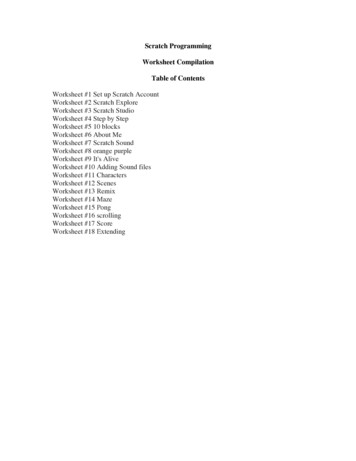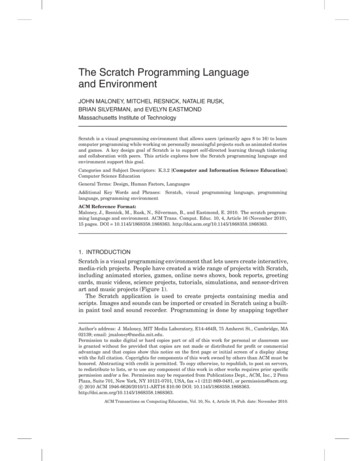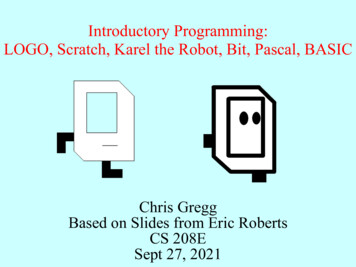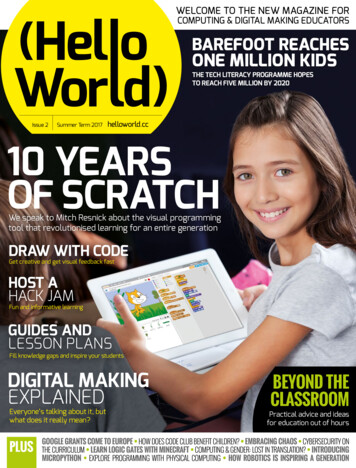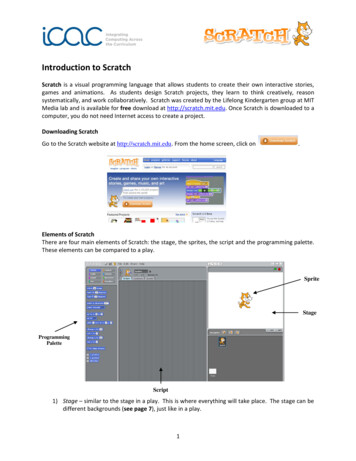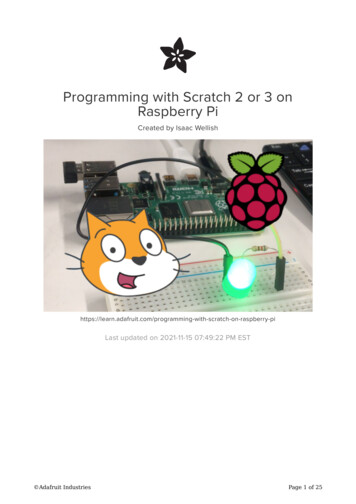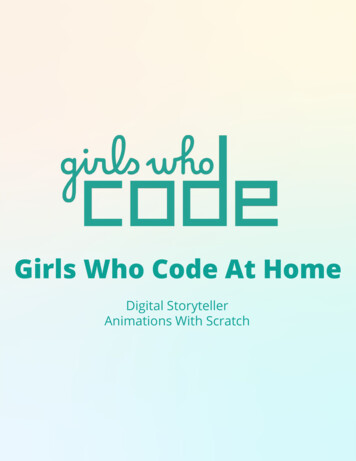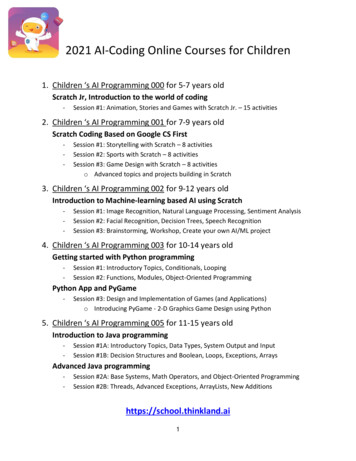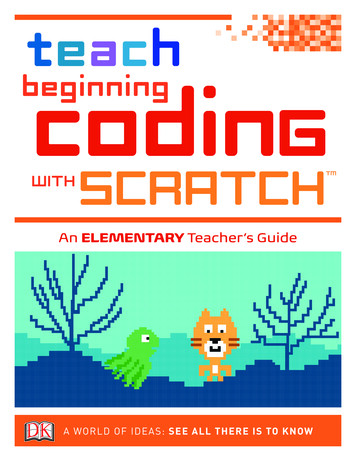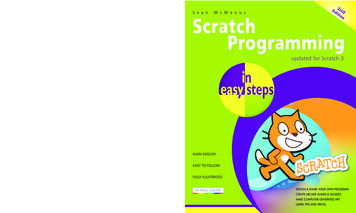
Transcription
Introducing Machine Learning with Scratch andRobots as a Pilot Program for K-12 ComputerScience EducationChan-Jin ChungLawrence Technological University/Department of Mathematics and Computer Science, Southfield, Michigan, USAEmail: cchung@ltu.eduLior ShamirKansas State University/Department of Computer Science, Manhattan, Kansas, USAEmail: lshamir@ksu.eduAbstract—Machine learning (ML), a branch of artificialintelligence (AI), is a method that enables systems to learnfrom data for the purpose of recognizing patterns andmaking decisions without being explicitly programmed. Inthe past decade machine learning has been growing rapidly,and ML technologies such as speech recognition, spamfilters, smart email reply, online recommendations, facerecognition, fake news detection, and self-driving cars havebecome pivotal in modern daily life. However, computerscience education has not yet fully adjusted to thetremendous growth in the sub-field of AI. This paperdescribes an approach of introducing K-12 students to MLthrough an on-line summer camp. The students areintroduced to the concept of ML by hands-on activities ofdeveloping applications for recognizing text, numbers,sounds, images, and video data using a web-based cloudservice tool "Machine Learning for Kids" and Scratch 3programming language combined with Lego MindstormsEV3 robots. The results show that the tools and technologiesused in the camp are suitable for K-12 students, also whenused in the form of online training. Pre and post surveysshow that students express basic knowledge in ML andhigher interest in coding and STEM after being exposed tothe proposed training.Index Terms—artificial intelligence, computational thinking,computer science education, k-12 STEM education, onlinelearning, machine learning, robots, scratch codingI.INTRODUCTIONComputer Science (CS), Computational Thinking(CT), and coding skills are gradually becoming part ofthe K-12 school curricula worldwide [1]. According tothe Brookings Institute, out of 219 countries, 44 (around20 percent) mandate that schools offer it as an elective orrequired course, 15 (around 7 percent) offer CS in selectschools and some subnational jurisdictions (states,provinces, etc.) [2]. Multiple studies suggest that CS andCT education can help students beyond just computing,and CS education has been linked with improvedPresented online in 3rd International Conference on Future Learning(ICFL 2020), December 17-19, 2020, London, United Kingdomproblem-solving skills [3] and higher rates of collegeenrollments [4].In the past decade, AI, and in particular machinelearning, have been expanding very rapidly, and becameone of the fastest growing sub-fields of computer science,with direct impact on billions of people [5]. Although AIand ML are mature fields of study, the relatively suddenand sharp increase in their impact on CS and society hasbeen introducing new gaps in all levels of computerscience education [6, 7].While substantial attention has been given toundergraduate and graduate education in AI [7], thepivotal nature of AI in computer science and societyintroduces the need to also expose K-12 students to AI[8]. Exposing K-12 students to AI can provide them withAI literacy, and potentially attract them to academiceducation and consequently a career in AI. Therefore, ithas been proposed that AI should be studied at an earlyage [9, 10].An early example of efforts to develop educationalexperiences in AI was based on the development ofexpert systems [11]. More recent attempts were based onGoogle Teachable Machine [8], the Snap! blockprogramming language [6], or simple programmingenvironment such as HTML and JavaScript suitable forhigh school students [12].Here we propose an online machine learning K-12educational experience based on Machine Learning forKids (ML4K) [13] to introduce K-12 students to AI/ML,as well as CS, CT, and coding skills with robots [14].II.EDUCATIONAL OUTCOMESThe proposed educational experience makes use ofmultimedia data analysis to engage K-12 students in ML.The design is driven by the assumption that the use ofmultimedia data such as video can provide a broadervariety of options for hands-on projects that can be ofinterest to K-12 students.The primary expected outcome of the educationalexperience is providing K-12 students with ML and AIliteracy. Additionally, it also provides the students with
training in basic programming through the activitiesinvolved in implementing the ML tasks. Thedevelopment activities involve basic practicing of logicand problem-solving skills. Other educational outcomesinclude collaboration among the students, implementedthrough data collection, verification, and testing.A primary goal of the activities is to enhance the selfefficacy of the students, and increase their interest in CS,and particularly in ML/AI. Such experience canencourage more students to expand their CS educationthrough academic studies, consequently leading to careersin CS, ML, AI, or other STEM fields.III.RESEARCH METHODOLOGYThe research methodology aims at providing newknowledge regarding the following questions:(1) How feasible is the “ML for Kids” environment as atool for providing online-based training in datacollection, training ML models, and using the modelsto create apps in Scratch.(2) Whether the introduction of ML with robots leadsstudents to have more positive view of CS and STEMsubjects.(3) Whether the experience of ML with robots increasesstudents’ interest in CS and STEM careers.(4) Whether the hands-on experience of ML with robotsimproves students’ learning in CS and STEM.(5) What technical and pedagogical issues must beconsidered when designing CS curriculum with MLtools such as ML4K?A. ToolsTools considered for the camp were “TeachableMachine" [15] introduced by Google Creative Labs in2018 and web-based Machine Learning for Kids (ML4K)cloud service [13] built using IBM Watson APIs in 2017.The latter was selected for this experiment due to itsability to provide an easy-to-use guided environment withScratch 3 coding platform. Scratch 3 provides multipleextensions for robotics such as Lego Mindstorms EV3,Lego WeDo 2.0, and micro:bit.Scratch [16, 17] is a visual programming environmentthat allows users to learn computer programming whileworking on media-rich projects such as interactivestories, games, and animations. Scratch is designedespecially for ages eight to 16, but is used by people of allages. A key design goal of Scratch is to support selfdirected learning through tinkering and collaboration withpeers. Images and sounds can be imported or created inScratch using a built-in paint tool, webcam, and soundrecorder. Programming is done by snapping togethercolorful command blocks to control 2D graphical objectscalled “sprites", moving on a background called the“stage". Any tablets or mobile devices can also be used toprogram in Scratch 3 through the device’s web browser.The camp was delivered using Zoom, the onlineconferencing software. Before the camp, instructions toprepare things such as robot sensors and motors beforethe meeting were sent to adults (teachers, robotics teamcoach, or parents) who registered K-12 students online.User accounts and passwords for the ML4K were alsosent to the adults before the meeting day. In the beginningof the camp, presentation slides were provided to theparticipants. After the camp, recorded presentations weresent to the participants.B. Research ParticipantsWe offered two identical introductory level camps forthree online contact hours on July 10 and July 24, 2020.The second workshop took place August 14th, lasted twohour and 15 minutes, and was focused on video imagedata applications.We recruited students using the Robofest network.Robofest is an autonomous robotics competitionprimarily for 4th through 12 grade students focusing onlearning computer science and programming. Anyrobotics kits were allowed in the construction of robots.Robots can be programmed with any programminglanguage in Robofest [18, 19].Twenty-four students were enrolled for the 1st campon July 10th. Average grade was 7.7. 20 students wereregistered for the July 24 camp, where average grade was7.6. 29 students were enrolled for Aug 10th camp, whereaverage grade was 7.7. As a whole the total of 73 studentswere registered and the average school grade was7.7.However, 10 students did not show up to the Zoommeetings, and therefore the actual number of studentswho participated in the camps was 63.C. Data Collection MethodsA pre-survey link was included in the preparationinstruction file sent prior to the camp meeting day tocoaches. The anonymous pre-survey had four questionsas shown in Figure 1.A post-survey link was sent directly to the students atthe end of each camp day using the Zoom chat function.The anonymous post survey had exactly the same fourquestions as the pre-survey, as well as one additional newquestion as shown in Figure 2.IV.IN CLASS HANDS-ON AND MINDS-ON PROJECTSFigure 3 shows the Lego robot setup requested toprepare the camp. One color sensor, one distance sensor,and a Lego EV3 motor were used. EV3 intelligent brickis connected to the computer via Bluetooth connection.During the camp, after explaining concepts andshowing sample solutions for the following projects, theinstructor allowed some time to complete the projectduring the session. Students reported completion throughthe Zoom Chat.A. Types of ProjectsThe projects included a variety of tasks that involvedifferent types of data, demonstrating a relatively broadrange of options that can engage a variety of students.
Figure 1. Pre-survey questionsFigure 2. Post-survey questionsFigure 3. EV3 robot setup for the campRecognizing numbers. The purpose of the project isto create a simple model to recognize whether a numberrepresenting the value from an ambient light sensor isdark or bright. If dark, the color of the Scratch stagebackdrop should be changed to yellow.Text recognition. The students need to train a modelwith possible texts that can be used to turn on/off fanssuch as “Turn on the fan”, “It is hot here”, “Can we turnoff the fan?”, “Please turn the fan off”, and “It’s cold”.The students are asked to write a Scratch code to turn onthe Lego motor based on keyboard text entered using thetrained model.Recognizing sounds. In this project the students areasked to collect recordings of your own voice when yousay “on” and “off” and train a model to recognize them.For sound projects, students are also required to collectexamples of background noise to help the computer tolearn to recognize your sounds. Then, the students write acode to turn the Lego motor fan on or off according tovoice command using the trained model.Recognizing Images. The students collect images of“Rock” and “Paper” by showing their hand to thewebcam. Then, the students train them to recognize whentheir hand makes either “Rock” or “Paper”. The studentsthen create costumes of the sprite to use as the imageinputs of the model by showing their hands to thewebcam.Recognizing two Lego sensor data. This projectinvolves the recognition of two number values problem toturn on the Lego motor fan only when the light sensordetects dark and the distance sensor detects a near object.A Scratch code must collect data through a light sensorand a distance sensor to train a model.Color your nose red. The students use a pre-trainedmachine learning model to detect a face on a live webcamvideo, and code animated effects on their nose.Alarm if no mask detected. The students first collectimages of people wearing face masks, as well as imagesof people not wearing masks. The students then use theimages to train a model to recognize whether a person onan image wears a mask or not. No code was required.Alarm if the user is not wearing a mask. Thestudents collect images of themselves wearing facemasks, as well as images of themselves when not wearinga mask using the webcam function in ML4K. Aftertraining the model, the code should recognize whether thestudent is wearing a mask or not in real-time. Figure 4describes blocks and process of this project.Pose detection – Wrist Up or Down. The students usea pre-trained ML model provided by ML4K to detect thelocation of the right-hand wrist. Students then create andtrain their own ML model to recognize whether theirwrist position is up or down. The app should make aspecial sound only when the right hand is up. Figure 5shows the high-level blocks of the project for training andinference processes. Figure 6 shows two scripts thatcollects Wrist-up images and wrist-down images.
Figure 4. Project to alarm if no mask is detectedFigure 7. Scratch code to inference if the wrist is upV.Figure 5. Project to detect wright wrist is up or downFigure 6. Scratch scripts to collect wrist up and down imagesRESULTSAccording to the Zoom chat log, approximately 40%of the students completed the in-class projects. Studentswho did not complete their projects were asked tocomplete their projects after the camp. However, becausethe ML4K account only saves training data and trainedmodels, code for projects completed after the sessionscould not be collected.A total of 41 students participated in the pre-surveyand 45 students participated in the post-survey. Thesurvey had two questions directly related to basicknowledge in ML concepts. For Question 3 in Figure 1,91% of students answered immediately after taking thecamp. Fifty eight percent of the students answeredcorrectly the same question in the pre-survey. ForQuestion 4 in Figure 1, 78% of the students answeredcorrectly in the pre-survey, while 99% answered correctlyin the post survey.The percentage of students indicating that they likeSTEM/Coding increased from 80.5% in the pre-survey to91.1% in the post-survey. Figure 8 shows the result of preand post surveys for Question 1. Using t-test statistics, theprobability to have such difference by mere chance is(P 0.016).Figure 7 shows the code that trains the model, get (x,y) positions of the wrist on the current image, move theSprite to that location, and then ask the local trainedmodel if the wrist is up by sending the current (x, y)position. If that is true, you will hear a pop sound.B. Mini Project CompetitionRobofest defines a “camp” as “hands-on workshops Mini project competitions” [18]. It is a teaching methodfor STEM CS education in the context of constructivistlearning theory [20]. The camp was delivered in an onlineformat, and the students were asked to submit sourcecode files as well as video links of their own miniprojects for prizes within 60 hours, after the meeting.Figure 8. The result of pre and post surveys for Question 1. The errorbars are the standard error of the means.
In the post survey, 100% of the students also expressedthat they would consider a career involving Coding,Science, Technology, Engineering, or Math. The changewas from 95.1%. Figure 9 shows the result of pre andpost survey for Question 2 about STEM career plan. Theprobability of such difference to occur by chance is (P0.043).Figure 9. The result of pre and post surveys for Question 2.A majority (44.4 37.8 82.2%) of students indicatedthat the ML camp experience helped them learn moreabout Coding, Science, Technology, Engineering, orMath as in Figure 10.people in virtually all aspects of modern lives, and thetrend of increasing impact of AI is bound to continue.The growing importance of AI and ML in computerscience and society reinforces the introduction of AI andML concepts to students at an early stage.Here we described an online educational experiencedesigned for K-12 students, based on Machine Learningfor Kids (ML4K)” system with Scratch and Lego EV3robots. The preliminary results show that using ML4K incombination with Lego EV3 is feasible, engages K-12students, and leads to positive attitude of the participantstowards ML, AI, CS, and STEM in general.Based on the surveys, projects completed, and accountdata, it is clear that the use of ML4K environment issuitable for teaching the concept of ML so that studentscan create apps using the models they created and trained.Also, it is shown that the introduction of ML with robotsimproves students’ likeness in CS and STEM subjects.The experience of ML with robots also increasesstudents’ interest in CS and STEM careers, and thehands-on experience of ML with robots improvesstudents’ learning.Observations of communication with the studentssuggested that students working on projects related tomultimedia content such as video, images, sound, andnatural language data were more motivated compared tothe other students.The ML4K environment allows students to collect andverify training data examples through collaboration witheach other. Future work will include design that betterenables collaboration between students through an onlineplatform.CONFLICT OF INTERESTThe authors declare no conflict of interest.Figure 10. The result of post survey for Q5: This camp helped me learnmore about Coding/STEM.Regarding the home work mini projects, a total of 9projects were submitted. Selected projects for prizes areas follows: Smart Mask Detector:https://youtu.be/kkpFaDUhXj8 Smart Shopper: https://youtu.be/CmnwfPzYXIE Recognizing handwriting to turn on/off a Legorobot fan: https://youtu.be/UEgeDiKJ6rc Mood Recognition:https://youtu.be/LH5pInLapMo Counting the number of sit-ups:https://youtu.be/RVTMlQs MWI Flappy bird game: https://youtu.be/kvJSJuzONsk Wear a mask: https://youtu.be/-bedMApwKA8VI.CONCLUSIONAI and ML technologies have been growingsignificantly over the past decade, impacting billions ofAUTHOR CONTRIBUTIONSChan-Jin Chung organized the summer camps,developed curriculum, taught the online camps, andcollected the data; Lior Shamir assisted with the camps,analyzed the data, and wrote the paper; Both authorsconducted the research and approved the final version.ACKNOWLEDGMENTThis work was supported in part by a sponsorship fromDENSO, Southfield, Michigan, USA. The camps werehosted by Lawrence Technological University’sRobofest (https://www.robofest.net) program.REFERENCES[1][2]Amanda Sullivan and Marina Bers. 2019. Computer scienceeducation in early childhood: the case of Scratch Jr. Journal ofInformation Technology Education: Innovations in Practice 18, 1(2019), 113–138.Emiliana Vegas and Brian Fowler. 2020. What do we know aboutthe expansion of K-12 computer science education? A review of
17][18][19][20]the evidence. nce-education/Ruqayya Toorawa Shima Salehi, Karen D. Wang and CarlWieman. 2020. Can Majoring in Computer Science ImproveGeneral Problem-solving Skills?. In SIGCSE ’20: Proceedings ofthe 51st ACM Technical Symposium on Computer ScienceEducation. ACM, 156–161.Emily Anne Brown and Richard S. Brown. 2020. The Effect ofAdvanced Placement Computer Science Course Taking onCollege Enrollment. s/6/9/6/7/69675515/longitudinal study - combined report final 3 10 20 jgq .pdfGiang Nguyen, Stefan Dlugolinsky, Martin Bobák, Viet Tran,Álvaro López García, Ignacio Heredia, Peter Malík, and LadislavHluch y. 2019. Machine Learning and Deep Learning frameworksand libraries for large-scale data mining: a survey. ArtificialIntelligence Review 52, 1 (2019), 77–124.K Megasari Kahn, Rani Megasari, Erna Piantari, and EnjunJunaeti. 2018. AI programming by children using snap! blockprogramming in a developing country. 13th European Conferenceon Technology Enhanced Learning (2018).Weidong Liao and Osman Guzide. 2019. Teaching artificialintelligence for undergraduate students: a project based approach.Journal of Computing Sciences in Colleges 34, 3 (2019), 132–132.Tapani Toivonen, Ilkka Jormanainen, Juho Kahila, Matti Tedre,Teemu Valtonen, and Henriikka Vartiainen. 2020. Co-DesigningMachine Learning Apps in K–12 With Primary School Children.In 2020 IEEE 20th International Conference on AdvancedLearning Technologies (ICALT). IEEE, 308–310.David Touretzky, Christina Gardner-McCune, Fred Martin, andDeborah Seehorn. 2019. Envisioning AI for K-12: What shouldevery child know about AI?. In Proceedings of the AAAIConference on Artificial Intelligence, Vol. 33. 9795–9799.Randi Williams, Hae Won Park, Lauren Oh, and CynthiaBreazeal. 2019. Popbots: Designing an artificial intelligencecurriculum for early childhood education. In Proceedings of theAAAI Conference on Artificial Intelligence, Vol. 33. 9729–9736.CF Reynolds. 1988. Introducing expert systems to pupils. Journalof Computer Assisted Learning 4, 2 (1988), 79–92.Radu Mariescu-Istodor and Ilkka Jormanainen. 2019. MachineLearning for High School Students. In Proceedings of the 19thKoli Calling International Conference on Computing EducationResearch. 1–9.D Lane. 2018. Machine learning for kids. qin Yang, Xin Liu, and Guang Chen, "Global Research Trendsin Robot Education in 2009-2019: A Bibliometric Analysis,"International Journal of Information and Education Technologyvol. 10, no. 6, pp. 476-481, 2020.2018. Teachable Machine. John Maloney, Mitchel Resnick, Natalie Rusk, Brian Silverman,and Evelyn Eastmond. 2010. The scratch programming languageand environment. ACM Transactions on Computing Education(TOCE) 10, 4 (2010), 1–15.Mitchel Resnick, John Maloney, Andrés Monroy-Hernández,Natalie Rusk, Evelyn Eastmond, Karen Brennan, Amon Millner,Eric Rosenbaum, Jay Silver, Brian Silverman, et al. 2009. Scratch:programming for all. Commun. ACM 52, 11 (2009), 60–67.ChanJin Chung, Christopher Cartwright, and Joe DeRose. 2017.Robotics festival and competitions designed for STEM Ceducation. In Robotics in STEM education. Springer, 131–170.CJ ChanJin Chung, Christopher Cartwright, and Matthew Cole.2014. Assessing the impact of an autonomous roboticscompetition for STEM education. Journal of STEM Education:Innovations and Research 15, 2 (2014).Andreas Zendler, "Teaching Methods for Computer ScienceEducation in the Context of Significant Learning Theories,"International Journal of Information and Education Technologyvol. 9, no. 7, pp. 470-476, 2019.Copyright 2020 by the authors. This is an open access articledistributed under the Creative Commons Attribution License (CC BYNC-ND 4.0), which permits use, distribution and reproduction in anymedium, provided that the article is properly cited, the use is noncommercial and no modifications or adaptations are made.Chan-Jin Chung attended HongIk Universityin Seoul, Korea, where he earned a B.S.Computer Science degree. While he wasworkingforElectronicsandTelecommunication Research Institute (ETRI)as a research scientist from 1982 to 1992, hewas involved in developing TDX switchingsystems that became later the base system forthe first commercialized CDMA system in theworld. Chung also worked as a visitingresearcher to develop telecommunication software modules for L.M.Ericsson in Sweden in 1983-1984. He received his Ph.D. in ComputerScience from Wayne State University in 1997. His doctoral researchwas the development of a self-adaptive AI system motivated by culturalevolution process, which was then applied to solve various optimizationproblems. He was an advisor of LTU team who won 1st place award in3D design optimization competition sponsored by HONDA R&DEurope GmbH as a part of World Congress in ComputationalIntelligence Conference in 2002. His research interests includeevolutionary computation, cultural algorithms, evolutionary-neurofuzzy algorithms, deep neural network learning, evolutionary robotics,and robotics in education. Prof. Chung founded a world-wideautonomous robot competition called Robofest (www.robofest.net).Over 28,000 students from 16 US States and 28 countries haveparticipated in the competition since 1999. He launched numerousSTEM CS education programs such as RoboParade, a parade ofautonomous vehicles in 2006, Vision Centric robot Challenge in 2007,and CS PA2: Learning Computer Science with Physical Activities andAnimation. He is a faculty advisor of LTU’s IGVC (Intelligent GroundVehicle Competition) teams since 2003. His H2Bot team won 1st placedesign award in 2007. His team was also selected to represent USA tocompete at RoboCup Four-legged robot soccer division in 2007.BigBoot II team won Grand Award LESCOE Cup in 2016. He served asthe USA National Organizer for World Robot Olympiad in 2014 and2015. Currently, he leads ACTor (Autonomous Campus TranspORt)project using a drive-by-wire electric vehicle. The ACTor vehicle teamwon the Self-Drive Challenge competition at the IGVC in 2017 and2018. In 2011, IEEE USA honored Dr. Chung with its citation of honoraward for his leadership in STEM education.Lior Shamir Graduated with a Bachelor’s incomputer science from Tel Aviv University in1998, M.S. in computer science from OpenUniversity in 2003, and Ph.D in computationalscience and engineering from MichiganTechnological University in 2006.He was research fellow at the NationalInstitute on Aging, Assistant and AssociateProfessor of computer science at LawrenceTechnological University, and AssociateProfessor and Nick Chong Research Faculty Scholar at Kansas StateUniversity, department of computer science. Dr. Shamir authored over100 peer-reviewed publications, and a member of numerous scientificcollaborations such as the Midwest Big Data Hub (MBDH), the VeraRubin Observatory (formerly LSST), the Astrophysics Source CodeLibrary (ASCL), and more.
Scratch 3 coding platform. Scratch 3 provides multiple extensions for robotics such as Lego Mindstorms EV3, Lego WeDo 2.0, and micro:bit. Scratch [16, 17] is a visual programming environment that allows users to learn computer programming while working on media-rich projects such as interactive stories, ga
